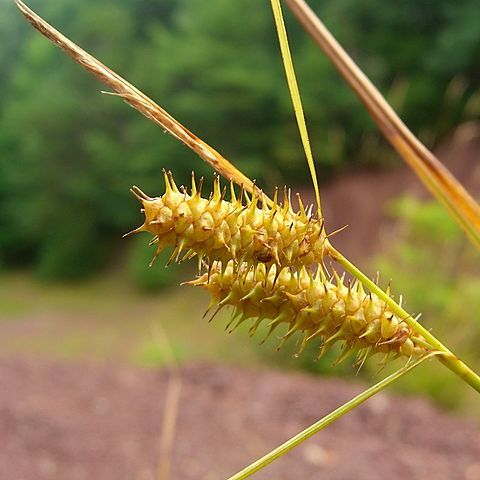Plants densely to loosely cespitose; rhizomes short, no more than 10 cm. Culms sharply trigonous in cross section, 20–65 cm, scabrous-angled distally. Leaves: basal sheaths reddish purple; ligules as long as to longer than wide; blades dark green, flat to W-shaped, widest leaves 2.4–4(–5) mm wide, glabrous. Inflorescences 3–16(–22) cm; proximal bract 12–40(–55) cm, greatly exceeding inflorescence; proximal 1–2(–3) spikes pistillate, proximal spreading to pendent, the distal erect, 9–14(–15) mm thick, 2.5–3.5 times as long as wide; terminal 1 spike staminate. Pistillate scales narrowly oblong, 2.9–9.8 × 0.3–0.9 mm, as long as or shorter than perigynia, margins often ciliate, apex truncate to retuse, erose and prolonged into a scabrous awn. Staminate scales scabrous-awned, sometimes ciliate-margined. Perigynia ascending to spreading, strongly 5–9-veined, veins separate nearly to beak apex, broadly ovate to nearly orbiculate, 4.8–6.5(–7.6) × 1.8–2.7 mm, apex abruptly contracted; beak 2.2–4 mm, 0.7–1.3 length of body, bidentulate, smooth, teeth straight, 0.1–0.6 mm. Stigmas 3. Achenes brown, trigonous, papillose.
More
Much like no. 222 [Carex lurida Wahlenb.], but seldom over 6 dm; main lvs 1–2 dm × 2–4 mm; ligule rounded, little if at all longer than wide; pistillate spikes 8–13 mm thick; perigynia 5–7 mm, the slender beak equaling or longer than the body; achene 1.5–2 mm. Swamps, woods, and wet meadows; N.H. to Va., Ky., and Tenn., chiefly in the mts.

